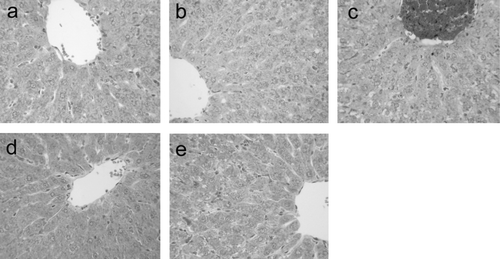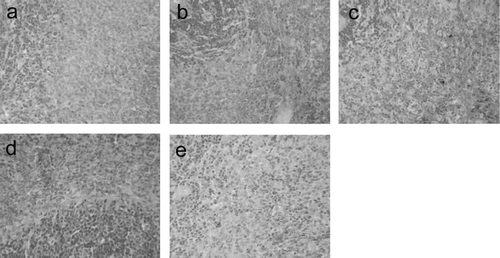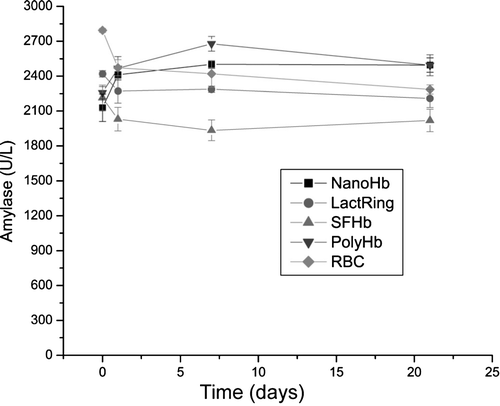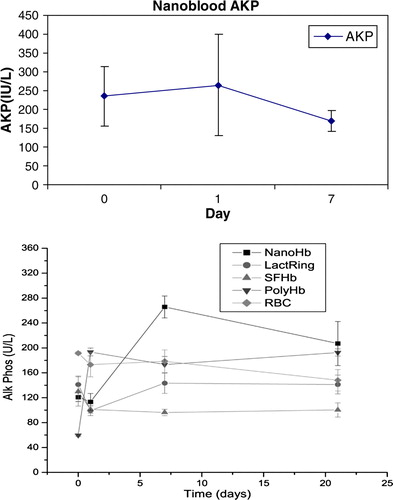Abstract
This study is to investigate the long-term effects of nanodimension PEG-PLA artificial red blood cells containing hemoglobin and red blood cell enzymes on the liver and spleen after 1/3 blood volume top loading in rats. The experimental rats received one of the following infusions: Nano artificial red blood cells in Ringer lactate, Ringer lactate, stroma-free hemoglobin, polyhemoglobin, and autologous rat whole blood. Blood samples were taken before infusions and on days 1, 7, and 21 after infusions for analysis. Nano artificial red blood cells, polyhemoglobin, Ringer lactate and rat red blood cells did not have any significant adverse effects on alanine aminotransferase, aspartate aminotransferase, alkaline phosphatase, creatine kinase, amylase and creatine kinase. On the other hand, stroma-free hemoglobin induced significant adverse effects on liver as shown by elevation in alanine aminotransferase and aspartate aminotransferase throughout the 21 days. On day 21 after infusions rats were sacrificed and livers and spleens were excised for histological examination. Nano artificial red blood cells, polyhemoglobin, Ringer lactate and rat red blood cells did not cause any abnormalities in the microscopic histology of the livers and spleens. In the stroma-free hemoglobin group the livers showed accumulation of hemoglobin in central veins and sinusoids, and hepatic steatosis. In conclusion, injected nano artificial red blood cells can be efficiently metabolized and removed by the reticuloendothelial system, and do not have any biochemical or histological adverse effects on the livers or the spleens.
| Abbreviations | ||
| Hb | = | hemoglobin |
| MetHb | = | methemoglobin |
| NanoRBC | = | nanodimension artificial red blood cells |
| PEG | = | polyethylene glycol |
| PLA | = | polylactide |
| PolyHb | = | polyhemoglobin |
| RBC | = | red blood cells |
| SFHb | = | stroma-free hemoglobin |
| RES | = | reticuloendothelial system |
| AKP | = | alkaline phosphatase |
| ALT | = | alanine aminotransferase |
| AST | = | aspartate aminotransferase |
| CK | = | creatine kinase |
| Tbil | = | total bilirumin |
| CH | = | cholesterol |
INTRODUCTION
The first artificial red blood cells (artificial RBCs) prepared by microencapsulation of hemolysate have oxygen dissociation curve similar to RBCs Citation[1]. However, these artificial RBCs, even with diameters of down to one micron, survived for a short time in the circulation after intravenous injection Citation[2]. Our study shows that the long circulation time of RBCs is due to the presence of neuraminic acid on the membrane Citation[3]. This led us to study the effects of changing surface properties of the artificial RBCs Citation[2], Citation[3]. This has resulted in significant increases in circulation time, but still not sufficient for clinical uses Citation[3]. Later, other researchers were able to increase the circulation time further by preparing smaller lipid membrane Hb artificial cells with diameter of about 0.2 micron Citation[4]. The incorporation of polyethylene glycol (PEG) onto the lipid membrane artificial RBCs resulted in useful increases in the circulation time Citation[5]. Ongoing efforts are being carried out to develop this in preclinical studies Citation[6]. We have used a biodegradable polymer, polylactic acid (PLA), for the microencapsulation of Hb, enzymes, and other biologically active material since 1976 Citation[7]. More recently, we started to prepare nanodimension artificial RBCs of less than 100 nanometers mean diameter using PLA membrane and other biodegradable polymers Citation[8–10]. We have replaced most of the 6 g/dl of lipid membrane in Hb lipid vesicles with 1.6 g/dl of biodegradable polymeric membrane material. This marked decrease in the lipid component would lessen effects on the RES and lessen lipid peroxidation in ischemia-reperfusion. Unlike lipid membrane, biodegradable polymeric membrane is permeable to glucose. Thus, the inclusion of RBC enzymes prevents MetHb formation, even at 37°C, and we can also convert MetHb to Hb at 37° C (11-13). In addition, unlike lipid membrane, the nanocapsule membrane allows plasma factors like ascorbic acid to enter the nanocapsules to prevent MetHb formation. In order to increase the circulation time, we synthesized a new PEG-PLA copolymer to prepare Nano artificial RBCs Citation[11–13]. After extensive research, we now have a circulation time in rats that is double that of polyhemoglobin Citation[11–13]. Our previous reports showed that the PEG-PLA artificial RBCs has no adverse effect on the renal function and systemic biochemistry Citation[14]; in this report, we investigated the effect of 1/3 volume toploading infusions with PEG-PLA Nano artificial RBCs on the livers and spleens when followed on days 1, 7, and 21 after infusions.
MATERIALS AND METHODS
Preparation of Hb Solution
Stroma-free hemoglobin was prepared by the method as described Citation[12]. Briefly, SFHb was obtained by hypotonic hemolysis of bovine RBCs and it was made stroma-free by toluene extraction and high-speed centrifugation. The resulting solution contained 10–15 g Hb/dl.
Preparation of PolyHb
This has been described in detail Citation[13]. Briefly, 0.5 M glutaraldehyde was added and allowed to react for 24 hr at 4° C under anaerobic conditions with constant stirring. The reaction was stopped with excess 2.0 M lysine HCl at a molar ratio of 100:1 (lysine/Hb). Removal of reactants and free Hb molecules were carried out using dialysis and molecular exclusion chromatography Citation[13].
Preparation of PEG-PLA Nano Artificial RBCs
This has been described in detail Citation[13]. Briefly, PEG-PLA copolymer was prepared from 1.5 g of D,L-PLA[M.W. 15,000] and 0.75 g of methoxypolyethylene glycol [M.W. 2000] Citation[13]. Just before use, 150 mg of the PEG-PLA copolymer were dissolved in 8 ml acetone. Fifty mg of hydrogenated soybean phosphatidylcholine (Avanti Polar Lipids, Alabaster, AL) were dissolved in 4 ml ethanol. The two solutions were mixed and emulsified with the PolyHb solution to form Nano artificial RBCs. This could be followed by glutaraldehyde crosslinking to reduce the permeability of the membrane Citation[13]. This was then followed by vacuum solvent extraction to remove the organic solvent and high porosity ultrafiltration to remove unencapsulated Hb or PolyHb Citation[13].
Toploading
Twenty male Sprague-Dawley rats in the weight range of 300±40 g were used. They were randomly assigned into 5 groups. Each group received one of the following solutions: 1, PEG-PLA Nano artificial RBCs in Ringer lactates; 2, LactRing as control; 3, SFHb; 4, PolyHb; 5, Autologous rat RBCs.
Rats were anesthetized with sodium pentobarbitum (60 mg/kg), then unilateral femoral vein was cannulated using 3 cm length PE10 tubing (0.28 mm inner, 0.61 mm outer diameter, Clay Adams, Becton Dickinson, Sparks, MD, USA). Each rat received intravenous infusion of 33% of the total blood volume of one of the above 5 solutions. Total blood volume in ml was calculated as 6.5% of body weight in grams.
Histology Study
At day 21 after injection of various solutions, rats in all groups were sacrificed; the liver, spleen, and lung were excised for histology examination. The tissue specimen was fixed in 10% formalin solution, embedded in paraffin, then cut into serial 5-µm thick sections, mounted on slides, and then sections were stained with hematoxylin and eosin (H&E) for histology examination.
Blood Chemistry
Blood samples were taken from rats before injections, and on days 1, 7, 21 after injections. Plasma samples were stored in −76°C freezer until tested in the analytical laboratory of the McIntyre Animal Centre, McGill University. Blood alkaline phosphatase (AKP), alanine aminotransferase (ALT), aspartate aminotransferase (AST), creatine kinase (CK), total bilirubin (TBil), cholesterol (CH), amylas, and creatine kinase (CK) were determined.
Statistics
Blood chemistry assays were presented as mean±S.E. For multiple comparisons of biochemical data in all groups, we performed one-way analysis of variance (ANOVA). A p-value of less than 0.05 was considered significant.
RESULTS
Histology
There was no observable adverse effect on the microscopic histology of the liver receiving toploading of PEG-PLA Nano artificial RBCs, LactRing, PolyHb, or autologous RBCs. However, in the liver of the SFHb infused animals there is accumulation of Hb in the central vein and sinusoids, and steatmotosis (). There were no microscopic abnormalities in the spleens of all groups ().
Biochemistry
shows that 33% volume toploadings of Nano artificial RBCs, LactRing, SFHb, PolyHb, or RBC do not result in elevation of the systemic levels of total bilirubin in rats. One day after infusion of Nano artificial RBCs there was a transient increase of total bilirubin, but on day 7 and 21, the total bilirubin levels were lower than the other solutions. It should be noted that the circulation half time of PEG-PLA Nano artificial RBCs was 24 hours in rats (). Since standard centrifugation did not remove PEG-PLA Nano artificial RBCs, both the nanoparticles and the Hb may have interfered with the measurement for total bilirubin on day 1. In rat the circulation half time of PolyHb after 30% toploading is 12 hours and that for SFHb is even less.
Figure 3. 33% toploading of Nano artificial RBCs, LactRing, SFHb, PolyHb, or RBC does not result in elevation of the systemic levels of total bilirubin in rats. (Mean±S.E.).
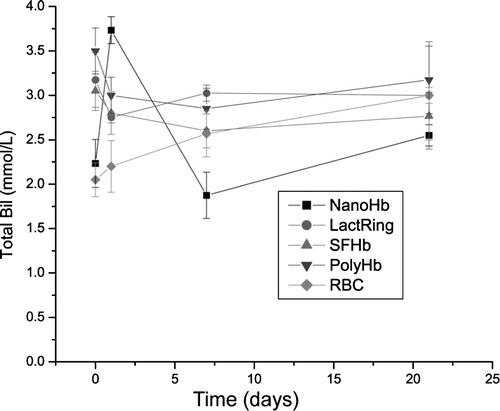
shows that the albumin level for the Nano artificial RBCs group remained the highest of all the solutions infused.
Figure 4. The albumin level for the Nano artificial RBCs group remained the highest of all the solutions infused. (Mean±S.E.).
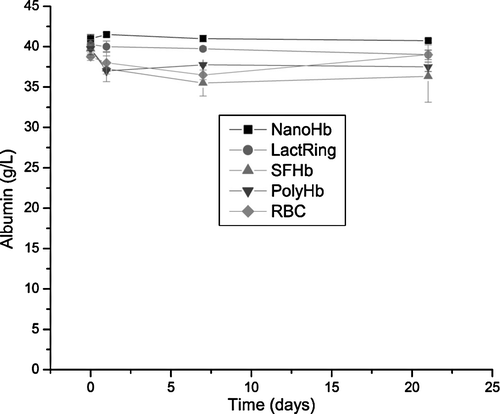
There was no elevation of the systemic cholesterol level for the groups receiving 33% volume toploading of Nano artificial RBCs, LactRing, SFHb, PolyHb or RBCs ().
Figure 5. There was no elevation of the systemic cholesterol level for the groups receiving 33% volume toploading of Nano artificial RBCs, LactRing, SFHb, PolyHb, or RBCs. (Mean±S.E.).
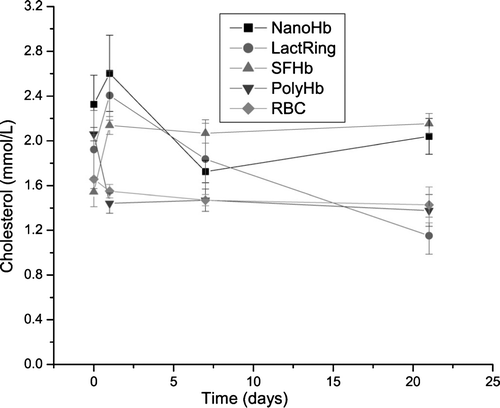
show that there was no elevation in the systemic levels of CK, AST or ALT in rats infused with 33% volume of Nano artificial RBCs. There was also no significant elevation of systemic levels of CK, AST, and ALT in rats infused with 33% volume of LacRing or RBCs. There was an increase in ALT on day 21 for PolyHb. Infusion of SFHb resulted in a consistent increase in the systemic level throughout the 21 days for AST and ALT.
Figure 6. Creatine kinase levels in rats infused with 33% volume of Nano artificial RBCs, LactRing, SFHb, PolyHb, and RBCs. (Mean±S.E.).

Figure 7. ALT levels in rats infused with 33% volume of Nano artificial RBCs, LactRing, SFHb, PolyHb, and RBCs. (Mean±S.E.).
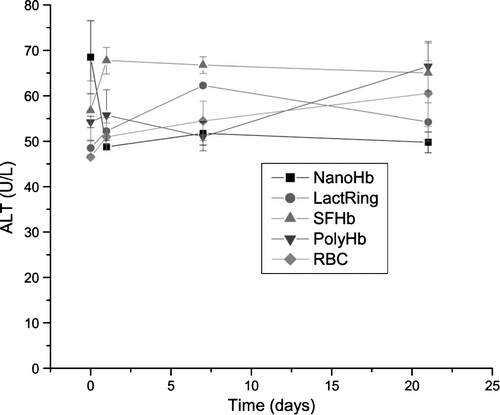
Figure 8. AST levels in rats infused with 33% volume of Nano artificial RBCs, LactRing, SFHb, PolyHb, and RBCs. (Mean±S.E.).
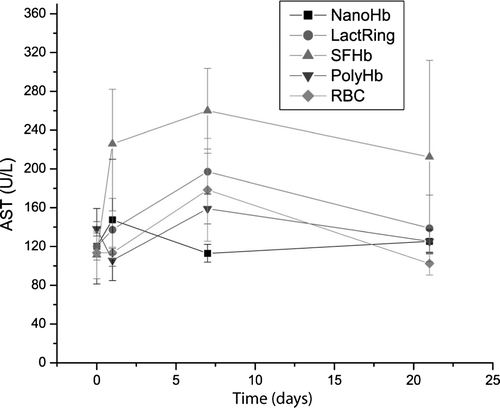
Infusion of 33% total blood volume of Nano artificial RBCs, LactRing, SFHb, PolyHb or RBC did not result in any significant increase in systemic amylase when compared to the control level before infusion (). AKP in rats infused with 33% volume of LactRing, SFHb, PolyHb, or RBC did not result in any significant changes throughout the 21 days. Infusion of Nano artificial RBCs resulted in an increase of AKP on day 7 ( upper) however, when this was repeated, the results did not show a significant increase ( lower).
DISCUSSION
In our present study we observed that SFHb caused liver function damage. The chemical cross-linking of hemoglobin with glutaraldehyde into polyhemoglobin when infused did not show damage to liver and spleen. Our results also showed that PEG-PLA Nano artificial RBCs containing Hb did not induce liver function disorders, and there were no histological abnormalities in the livers and spleens.
Our present results showed that the PEG-PLA Nano artificial RBCs can be sufficiently captured by RES and metabolized when systemically infused, and PEG-PLA Nano artificial RBCs artificial red blood cells do not have adverse effects on the RES. The PEG-PLA Nano artificial RBCs are very small so that they may effectively prevent embolization of capillaries and venules in microcirculation. Further studies will be carried out using electromicroscopic analysis and study of effects on phagocytic activities.
Acknowledgements
This research was supported by the Canadian Institutes of Health Research and the Quebec Ministry of Health's Hemovigillance Program in the form of a FRSQ Research Group (d'equip) on Blood Substitutes in Transfusion Medicine.
References
- Chang, T.M.S. (1957). Hemoglobin corpuscles. Report of a research project of B.Sc. Honours Physiology, McGill University, 1–25, Medical Library, McGill University (also reprinted in J. Biomaterials, Artificial Cells and Artificial Organs 16:1–9, 1988).
- Chang T.M.S. Semipermeable microcapsules. Science 1964; 146(3643)524
- Chang T.M.S. Artificial Cells. Monograph. Charles C. Thomas, Springfield, IL 1972
- Djordjevich L., Miller I.F. Synthetic erythrocytes from lipid encapsulated hemoglobin. Exp. Hematol 1980; 8: 584
- Philips W.T., Klpper R.W., Awasthi V.D., Rudolph A.S., Cliff R., Kwasiborski V. V., Goins B.A. Polyethylene glyco-modified liposome-encapsulated Hb: a long circulating red cell substitute. J. Pharm. Exp. Therapeutics 1999; 288: 665–670
- Kobayashi, K., Tsuchida, E., Horinouchi, H., eds. (2005). Artificial Oxygen Carriers, Springer-Verlag Publisher, MontrealCanada.
- Chang T.M.S. Biodegradable semipermeable microcapsules containing enzymes, hormones, vaccines, and other biologicals. J Bioengineering 1976; 1: 25–32
- Chang, T.M.S. , Yu, W.P. (1997). Biodegradable polymer membrane containing hemoglobin as potential blood substitutes. U.S.A. Patent 5670173, September 23.
- Yu W.P., Chang T.M.S. Submicron biodegradable polymer membrane hemoglobin nanocapsules as potential blood substitutes: a preliminary report. Artificial Cells, Blood Substitutes and Immobilization Biotechnology, an International Journal 1994; 22: 889–894
- Yu W.P., Chang T.M.S. Submicron biodegradable polymer membrane hemoglobin nanocapsules as potential blood substitutes. Artificial Cells, Blood Substitutes and Immobilization Biotechnology, An International Journal 1996; 24: 169–184
- Chang T.M.S., Powanda D., Yu W.P. Ultrathin polyethylene-glycol-polylactide copolymer membrane nanocapsules containing polymerized Hb and enzymes as nano-dimension RBC substitutes. Artificial Cells, Blood Substitutes & Biotechnology, An International Journal 2003; 31: 231–248
- Chang T.M.S. Therapeutic applications of polymeric artificial cells. Nature Review: Drug Discovery 2005; 4: 221–235
- Chang T.M.S. Monograph on ARTIFICIAL CELLS: Biotechnology, Nanotechnology, Blood Substitutes, Regenerative Medicine, Bioencapsulation, Cell/Stem Cell Therapy. World Science Publisher, Singapore 2007
- Liu, Z.C. , Chang, T.M.S. (2008). Effects of PEG-PLA-nano artificial cells containing hemoglobin on kidney function and renal histology in rats. Artificial Cells, Blood Substitutes & Biotechnology, An International Journal 36: in press.
